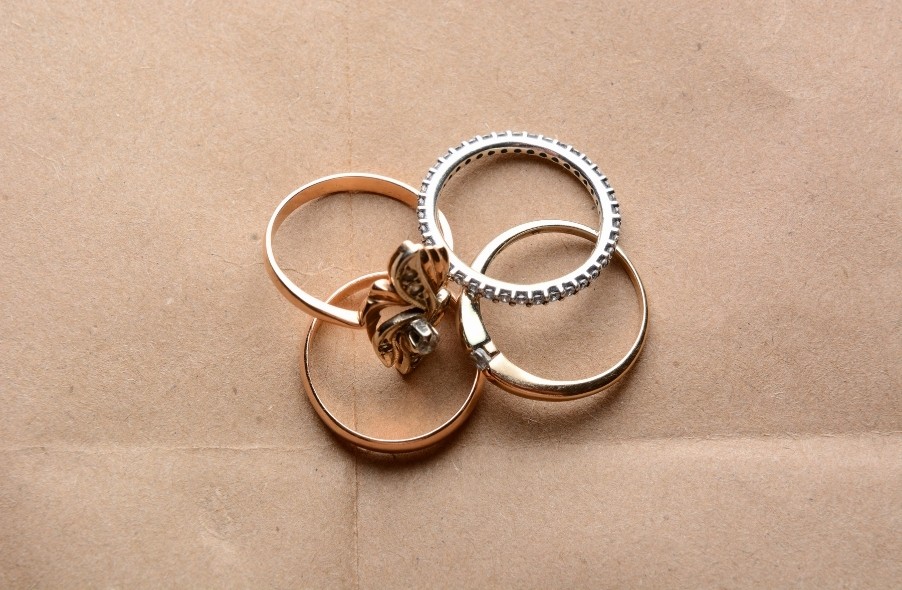14k vs 18k gold: Which one between the two you should consider? Investing in gold plays a vital role in any investment portfolio, especially if you want to diversify your assets. Compared to other precious metals, gold has held its value for decades. It remains a tangible investment and a proven hedge against inflation.
Experts agree that gold investment increases in value when higher inflation and economic instability prevail. The reason is that the value of gold has no relation to the currencies’ performance and other investments in the stock market. In July 2020, gold prices increased to record levels due to growing economic uncertainties.
If you wish to expand your investment portfolio by buying gold, you may wonder which option works best for you. While some prefer investing in bullion coins, others consider jewelry.
Buying 14K or 18K gold has proven to be an excellent investment option for many people. Keep reading to discover the differences between 14K and 18K gold and which one to add to your investment portfolio.
14K and 18K Gold Overview
We consider both 14K and 18K as gold mixed with an alloy, a combination of several other metals. The ratio of metals determines the type. With a 14 to 10 ratio, 14K gold contains approximately 58% of pure gold and 42% other metals such as nickel, copper, rhodium, and zinc. The alloy is much stronger than pure gold, meaning it is perfect for durable jewelry and accessories that will last for a lifetime. 14K gold is also known as 583 gold.
On the other hand, 18K alloy refers to 18 parts of pure gold and six parts of metals like nickel, copper, silver, and zinc to increase its strength and resistance. 18K gold contains 75% pure gold and 25% of other metals. It has more richness and vivid color than 14K gold, so jewelers use it to produce fine jewelry. 18K gold is also known as 750 gold.
Karat vs. Carat
Before continuing to explain the differences between 14K and 18K gold, we must define the terms carat and karat.
Carat is a weight measurement of precious metals. When buying diamonds, carat weight will play a primary role in determining the value and price of the jewelry.
Karat (K) refers to the purity level of gold. The most common types include 10K, 14K, 18K, and 24K gold. Know that 24-karat gold is 100% gold, where all twenty-four parts contain pure gold.
14K vs. 18K: What Is the Difference?

While both gold alloys, 14K and 18K do have significant differences that can need to know before deciding to invest.
Durability and Strength
Since 14K gold contains more metals than 18K, it becomes stronger and more durable. When considering adding gold to their investment portfolio, many people turn to 14K because of its resilience, knowing it will stand the test of time and last for years without rusting or changing its color.
In contrast, 18K gold is much closer to pure gold’s (24K) softness, making it more susceptible to scratches. If you want to preserve its color and beauty, you might have to clean and polish the gold more frequently.
In terms of color, yellow gold makes a much softer product than white gold because it doesn’t have an extra coating layer. White gold usually contains rhodium, which adds extra strength. When compared, 14K or 18K yellow gold offers less durability than 14K or 18K white gold.
Color
Pure gold manifests in vivid yellow color with orange or reddish tones. If the alloy contains higher gold purity, the warmer the color will be.
When it comes to 14K and 18K colors, it might be difficult to notice any differences, at least at first glance. If you analyze the piece carefully, you may see that 18K has a richer color. Most 18K gold jewelry pieces have a saturated yellow color with orange tones.
The 14K gold color depends on the alloyed metals. When compared to 18K gold, 14K has cooler tones.
Price
The price of a 14K or 18K gold piece varies between styles. Usually, 18K gold has a higher price than its counterpart due to the higher amount of gold. Besides the amount of gold purity, other factors that can affect the cost of gold per karat include the metals in the alloy, the brand, and additional precious stones.
Popularity
Both karats have various features and colors, meaning that their popularity and desirability can vary.
The modern appeal of 14K gold jewelry dominates in the U.S. and UK. It also serves as a popular choice for beginning investors who want to invest in gold that doesn’t cost as much as 18K gold and will last longer. The warmer tones of 18K gold rank higher in attractiveness for jewelry in most parts of Europe and Asia. It has a higher monetary value than 14K and provides an excellent investment option for all investors.
18K gold also makes an attractive option for vintage jewelry fans. If you love investing in old cold coins, then 18K gold jewelry might sound tempting. While it has a higher susceptibility to scratches than 14K gold, 18K looks enticing for vintage jewelry lovers due to the rustic flair and sheen that make any jewelry piece desirable.
Hypoallergenic Features
When it comes to investing in gold, people usually go for bullion coins or gold bars. Some choose gold jewelry instead because they can wear their investments and maintain them accordingly. If you want to invest in gold jewelry, it pays to know the hypoallergenic features of 14K and 18K gold to determine the better option.
In lower-karat gold jewelry, you may have a higher concentration of nickel. People who have allergies can be sensitive to 14K gold due to this nickel content.
Nickel is also present in 18K gold but in a minimal concentration. This usually doesn’t cause any reaction or irritation.
If you still want to go with 14K gold jewelry due to its durability and price, we suggest you go for a piece marked as nickel-free to ensure the alloy doesn’t cause a problem.
Pros and Cons of 14K and 18K Gold

As with many other precious metals, both 14K and 18K gold have positive and negative factors.
Pros of 14K Gold
- Affordability: Compared to its counterpart, 14K gold contains less pure gold; therefore, it generally costs less.
- Durability: Due to the higher concentration of metals, 14K gold is sturdier than 18K, guaranteeing better resistance to scratches. It makes the perfect choice for engagement rings, wedding bands, and people who have a more active lifestyle.
- Availability: 14K holds global popularity. Whether you want to invest in jewelry or expand your portfolio, consider 14K an excellent investment opportunity.
Cons of 14K Gold
- Potential Risk For Allergies: Because of the nickel concentration and other metals such as copper, iron, and zinc, 14K can cause irritation. If you have an allergy to some metal alloys, you might want to consider 18K jewelry instead.
- Appearance: Even though 14K gold jewelry rings or necklaces look lovely, they don’t have the glow and radiance that 18K gold has. When compared closely, 14K can look dull, with less gold color and shine.
Pros of 18K Gold
- High Purity: While 18K gold has many benefits, the most significant lies with its greater quantity of actual gold. While not as pure as 24K gold, it does have a near-pure appearance, especially noticeable in rose gold and yellow. You can recognize 18K gold by its incredible shine and vivid colors.
- Doesn’t Cause Allergies: Like 14K gold, 18K also contains metals such as nickel, copper, and zinc, but in lesser amounts.
Cons of 18K Gold:
- Cost: The higher cost (compared to 14K) can prove a major drawback of 18K. The price for buying 18K jewelry is much higher than 14K gold. Some rings and necklaces cost up to 150% more than jewelry made from 14K gold.
- Durability: While the higher amount of pure gold makes the jewelry look amazing, it also makes it softer and more susceptible to scratches.
Which One to Choose?
Both 14K and 18K make excellent options when buying jewelry or investing in precious metals. When deciding, it all comes down to budget, lifestyle, and future goals.
If you want a durable and affordable gold piece, 14K would be a more suitable option. 14K gold maintains a perfect balance between durability and appearance, and it gives you good value for your money. If you are okay with maintenance and regular cleaning for more vibrant and richer colors, you can’t go wrong with 18K. It also has higher monetary value, which often leads investors to add it to their portfolios.
Gold can be a valuable investment asset to have as part of your balanced portfolio. Compared to other precious metals, gold has some of the highest liquidity on the market and has increased in value more often. If you had invested $1000 into gold coins or gold jewelry 30 years ago, your original investment would have been worth over $5000.
Whether you want to expand your portfolio or invest in gold for the first time, we can help. Learn About Gold stands as your go-to source of investment information, providing you with details regarding bullion coins, gold bars, and gold in general.
Contact us today, and we’ll match you with a dedicated partner to help you find the best gold deals and offers.





